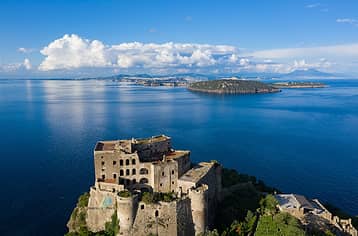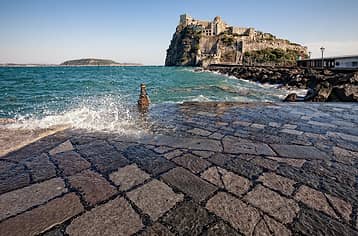- Home
- Experiences
- The Aragonese Castle, Ischia's most famous landmark
The Aragonese Castle, Ischia's most famous landmark


The Aragonese Castle is a fortification that sits on a volcanic-rock islet just off Ischia's eastern side. It is set in the village of Ischia Ponte, once known as Borgo di Celsa, and connects to the main island via a 220-meter (700-foot) stone walkway.
Visitors enter the castle via a tunnel excavated through the rock cliff on the small island in the mid-15th century under Alfonso V of Aragon; until the tunnel was built, the fortress could only be accessed from the sea via a ladder.
Today, this mighty castle with millennia of history is Ischia’s most famous landmark and the most popular tourist attraction. The complex is both striking and offers unparalleled views over the island of Ischia’s olive trees and Mt. Epomeo, as well as the nearby islands of Capri and Procida in Campania’s Gulf of Naples.
Visiting the Aragonese Castle
Visiting the Aragonese Castle
Ischia’s Aragonese Castle is open 7 days a week all year from 9 in the morning to sunset (for the precise closing time, contact segreteria@castelloaragonese.it). The last admission is one hour and half before closing.
There are snack bars and bookshops inside the castle complex.
Tickets:
Adults: €12
Children aged 10-18: €6
Children 0-9 years: free
How to Get to the Aragonese Castle
How to Get to the Aragonese Castle
The Aragonese Castle is located in Ischia Ponte.
From Ischia Porto (the island’s main port), take bus number 7 or a taxi; the trip takes around 15 minutes.
If you prefer to walk, you can reach the castle on foot from the port in about half an hour.
The History of Ischia’s Aragonese Castle
The History of Ischia’s Aragonese Castle
The first settlement on the islet where the castle now stands dates back to the fifth century BC, when Hieron I, Greek commander and tyrant of Syracuse, arrived with his fleet on the island to aid the Cumans in the war against the Tyrrhenians. He was later given the entire island as a reward for his assistance. The fortress was originally known as Castrum Gironis, Castle of Geron (Hieron’s brother). Over the centuries, the fortress passed into the hands of the Neapolitans and then the Romans, who used it as a watchpoint to spot enemy ships as they approached.
In the 5th and 6th centuries AD, the Aragonese Castle was used by Ischia’s inhabitants as a refuge from Visigoth and Lombard invasions and raids. In the following century, the Saracens repeatedly attacked the island but were unable to conquer the castle.
Since the Middle Ages, control of this strategic outpost has passed between a number of conquerors and dynasties in time with the complex history of Ischia and all of southern Italy. First it was controlled by the Norman dynasty under Prince Roger II, then the Swabians, when the castle became a prestigious noble residence. Afterwards, conflicts between Swabians and Angevins and, later, the rise of Alfonso of Aragon left its mark on the castle’s name and ownership.
The Court of Vittoria Colonna
The castle experienced its years of maximum splendor under the 'Aragonese domination, especially the reigns of Costanza d'Avalos and Vittoria Colonna in the 16th century. The latter lived in the fortress for 35 years, attracting important figures in literature and art during her decades there, including Ludovico Ariosto and Michelangelo Buonarroti.
With the end of the Aragonese control over Naples, the castle passed to the Spanish and then to the Austrians, subsequently suffering serious damage by the Bourbon army. Over the centuries, the Aragonese Castle of Ischia has also been used as a convent of the Poor Clares, as a prison, and as housing for retired soldiers.
After the unification of Italy, the castle became Italian state property and was largely abandoned and left as ruins. It was purchased by the lawyer Nicola Ernesto Mattera in the 20th century and his sons restored the fortress and opened it to the public.
Highlights
Highlights
The Aragonese Castle complex includes internal and external areas, religious buildings, and scenic terraces; it takes at least two hours to visit them all. Top sights include the Terrace of the Immaculate Conception, with breathtaking views over the village of Ischia Ponte and Pescatori Beach, and the Terrace of Olives, home to a panoramic bar where the castle gardens once stood. The 18th-century Church of the Immaculate Conception, Bourbon prison, and the 14th-century Cathedral of the Assumption with its frescoed crypt are also worth a visit.
The Cemetery of the Poor Clares
One of the most fascinating areas of the Aragonese Castle is the Cemetery of the Poor Clares located under the historic Church of the Immacolata. This space is lined by “scolatoi”, or masonry seats on which the lifeless bodies of deceased nuns were placed. The bodies slowly decomposed there until their skeletons were moved to the ossuary. Each day, the living nuns would pray for hours in front of their deceased sisters to reflect on the ephemeral nature of earthly existence. The nuns, forced to spend hours in this unhealthy environment, often fell ill and sometimes ended up occupying one of the cemetery’s “draining seats” themselves.